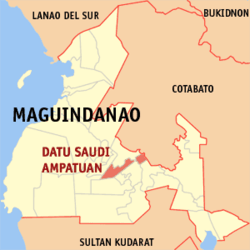Datu Saudi-Ampatuan, Maguindanao
| Datu Saudi-Ampatuan | |
|---|---|
| Municipality | |
| Municipality of Datu Saudi-Ampatuan | |
 Map of Maguindanao with Datu Saudi-Ampatuan highlighted | |
.svg.png) Datu Saudi-Ampatuan Location within the Philippines | |
| Coordinates: 6°57′26″N 124°26′40″E / 6.95722°N 124.44444°ECoordinates: 6°57′26″N 124°26′40″E / 6.95722°N 124.44444°E | |
| Country |
|
| Region | Autonomous Region in Muslim Mindanao (ARMM) |
| Province | Maguindanao |
| District | 2nd District |
| Barangays | 8 (see Barangays) |
| Government [1] | |
| • Type | Sangguniang Bayan |
| • Mayor | Neds Dimaukom |
| • Vice Mayor | Ans Sindatok |
| • Electorate | 15,470 voters (2016) |
| Area [2] | |
| • Total | 60.16 km2 (23.23 sq mi) |
| Population (2015 census)[3] | |
| • Total | 26,427 |
| • Density | 440/km2 (1,100/sq mi) |
| Time zone | UTC+8 (PST) |
| ZIP code | 9607 |
| PSGC | 153826000 |
| IDD : area code | +63 (0)64 |
| Climate type | Tropical climate |
| Income class | 4th municipal income class |
| Revenue (₱) | 59,217,877.04 (2016) |
| Native languages |
Maguindanao language Tagalog |
| Website |
www |
Datu Saudi-Ampatuan is a 4th class municipality in the province of Maguindanao, Philippines. According to the 2015 census, it has a population of 26,427 people.[3]
History
Datu Saudi-Ampatuan was created under Muslim Mindanao Autonomy Act No. 151 on July 1, 2003,[4][5] carved out of the municipality of Datu Piang.
On July 30, 2009, upon the ratification of Muslim Mindanao Autonomy Acts No. 225 (as amended by MMAA 252) and MMAA 222 (as amended by MMAA 253), the municipalities of Shariff Saydona Mustapha and Datu Salibo, respectively, were created from a total of 5 entire barangays and a portion of one barangay from Datu Saudi-Ampatuan, in addition to other barangays from Datu Piang, Datu Unsay, Mamasapano and Shariff Aguak.
Datu Saudi-Ampatuan mayor Samsudin Dimaukom, publicly accused by Philippine President Rodrigo Duterte of involvement in the illegal drug trade, was killed on October 28, 2016, along with nine others, by Philippine police at a highway checkpoint in what police describe as an anti-drug operation.[6][7]
Barangays
Datu Saudi-Ampatuan is politically subdivided into 8 barangays.[8]
- Dapiawan
- Elian
- Gawang
- Kabengi
- Kitango
- Kitapok
- Madia
- Salbu
Demographics
| Population census of Datu Saudi-Ampatuan | ||
|---|---|---|
| Year | Pop. | ±% p.a. |
| 2007 | 45,126 | — |
| 2010 | 20,330 | −25.19% |
| 2015 | 26,427 | +5.12% |
| Source: Philippine Statistics Authority[3] [9] [10] [11] | ||
Education
The Municipality has 1 Secondary School, the Dimaukom National High School formerly known as Datu Saudi Uy Ampatuan National High School with the school ID 318315. In school year 2015 - 2016 the number of students reached 444. It has 11 Regular Permanent Teachers and 6 Volunteer Teachers.
References
- ↑ "Municipality". Quezon City, Philippines: Department of the Interior and Local Government. Retrieved 31 May 2013.
- ↑ "Province: Maguindanao". PSGC Interactive. Quezon City, Philippines: Philippine Statistics Authority. Retrieved 12 November 2016.
- 1 2 3 Census of Population (2015). "ARMM – Autonomous Region in Muslim Mindanao". Total Population by Province, City, Municipality and Barangay. PSA. Retrieved 20 June 2016.
- ↑ "Muslim Mindanao Autonomy Act No. 151; An Act Creating the Municipality of Datu Saudi Ampatuan out of the Mother Municipality of Datu Piang in the Province of Maguindanao, Authorizing the Appropriation of Funds Therefor, and for Other Purposes" (PDF). Regional Legislative Assembly, Autonomous Region in Muslim Mindanao. Retrieved 27 January 2016.
- ↑ Philippine Statistics Authority (2008-04-16). "2007 Census of Population: Autonomous Region in Muslim Mindanao" (PDF). Archived from the original (PDF) on 2008-09-05. Retrieved 2008-05-19.
- ↑ https://www.nytimes.com/2016/10/29/world/asia/philippines-duterte-mayor-police.html?_r=0 (The New York Times)
- ↑ http://www.philstar.com/nation/2016/10/28/1638270/2-security-killed-along-narco-mayor-just-hired-private-firm (The Philippine Star)
- ↑ National Statistical Coordination Board. "PSGC Interactive: Municipality/City: DATU SAUDI-AMPATUAN". Retrieved 2008-05-19.
- ↑ Census of Population and Housing (2010). "ARMM – Autonomous Region in Muslim Mindanao". Total Population by Province, City, Municipality and Barangay. NSO. Retrieved 29 June 2016.
- ↑ Censuses of Population (1903–2007). "ARMM – Autonomous Region in Muslim Mindanao". Table 1. Population Enumerated in Various Censuses by Province/Highly Urbanized City: 1903 to 2007. NSO.
- ↑ "Province of Maguindanao". Municipality Population Data. Local Water Utilities Administration Research Division. Retrieved 17 December 2016.